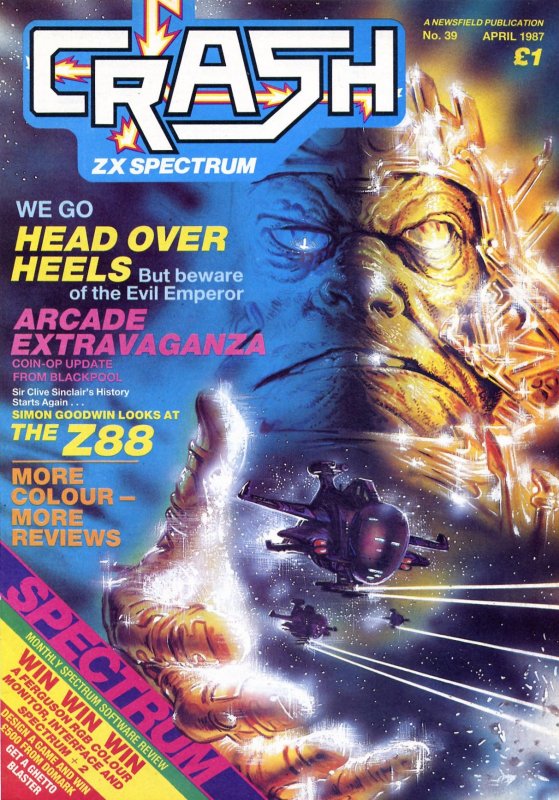

A new spirit swept CRASH; for the first time in ages Oliver and Roger were able to work together on ideas for the cover. The general opinion was to put Ocean’s Head Over Heels on the cover, but Oliver was alarmed that this could lead to yet another ‘cutesy’ picture. He wanted something tougher. Roger suggested basing the painting on the Evil Emperor instead, and using the idea of the space between the planets in the game’s scenario. That did the trick, and Oliver turned in one of the best pictures yet.
There was a new spirit indeed. It had already been suggested just after Christmas that CRASH was falling behind on colour content, that our rivals were providing more colour screenshots than we were. One of Roger Kean’s first jobs was to assess whether Newsfield’s increasingly experienced film-planners; already adept at putting tinted boxes, coloured text and so on into pages, could tackle the complexities of planning pages which included the laser-scanned four-colour separations from which full-colour photos are printed. This job would normally be undertaken by a professional repro house.
Cost had been the prohibiting factor. Normally it costs approximately £60 for every colour picture to be scanned by a laser scanner (the equipment is too expensive for Newsfield to have in-house): 30 reviews each getting two colour pictures would therefore cost around £3,600, far more than affordable. But if all the photographs taken from the monitor could be exactly the same size as each other, then whole batches of transparencies could be stitched together and scanned at the same time. (They’d have to be the same size so that when the pictures were all enlarged together by the same percentage they’d fit the magazine’s column widths precisely.)
When these sets of separations returned from the London company which does Newsfield’s scanning, the film-planning department could fit them into pages already laid out by our Art Department. Using this method, Roger and Cameron managed to trim the cost of screenshots down to about £10 per picture, enabling CRASH to go almost full-colour.
We tried the new system out with the April issue, though not with every screen, and it worked well. From now on CRASH would be colour throughout, whenever feasible. And because we now kept the separations, CRASH would always be able to reuse any picture whenever required at no extra cost for features like Playing Tips.
Lee Paddon’s interview with Australian programmer Steve Taylor went into the issue, but before it was printed it required an update. Steve worked for Melbourne House, but news arrived that Melbourne House UK had been sold to budget giants Mastertronic. It may have been a surprise to the public, but the deal, it seemed, had been under discussion for some time.
Mastertronic had come a long way since the days when their budget range was really cheap rubbish. But with labels like M.A.D. and Bulldog they were often putting out quality games at still very low prices, and now they owned one of the industry’s oldest and most respected full-price software houses — though it has to be said that Melbourne House had been going through a poor patch for some six months.
And here again was a second consecutive month where there were only two Smashes, and one was a budget game — in this case Firebird’s I, Ball. The other was, of course, Ocean’s Head Over Heels, widely regarded as the best game Jon Ritman and Bernie Drummond had written. It was hardly apparent at the time, but Head Over Heels was part of a new pattern for Ocean who, like the rest of us, realised that full-price games were fighting for their lives in the 8-bit marketplace. 1986 had been an uneven year for them and, because of the volume Ocean put out, they were as much to blame as anyone for the low profile licensed games had achieved in the public’s mind. And the budget houses were profiting from that.
An insight, one of rare honesty from a software publisher, was offered by Ocean’s Gary Bracey when he told CRASH that Ocean’s recent record had not been as good as it should have been, both for the quality of product and for the accuracy of advertised delivery time. It was this open recognition of past failings that would now motivate Ocean for the coming year; they would do their very best to offer value for money.